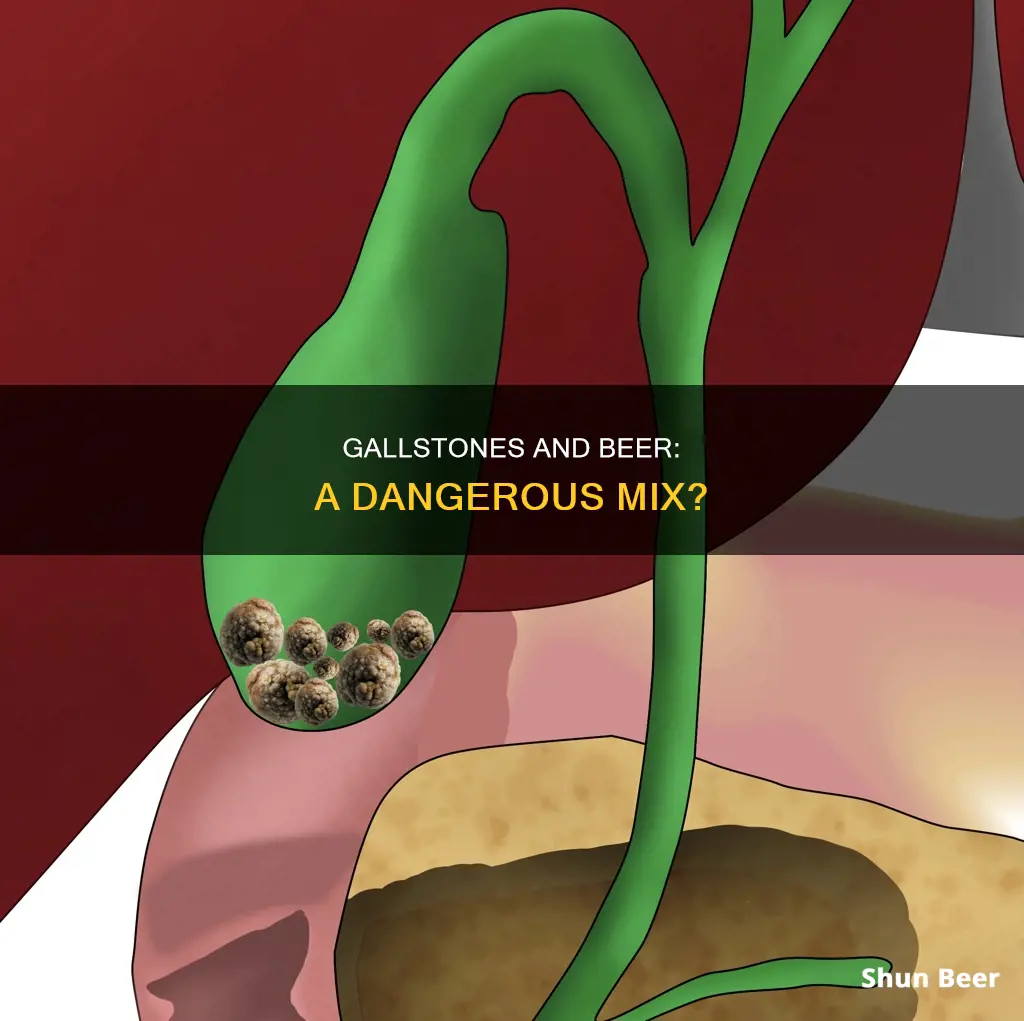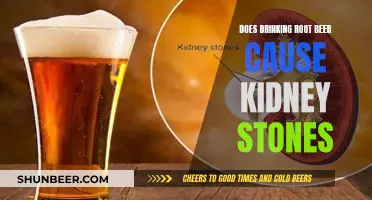
Gallstones are lumps of solid material that form in the gallbladder and are usually asymptomatic. While moderate alcohol consumption may lower the risk of gallstones, heavy drinking is associated with an increased risk of gallbladder cancer. Research suggests that alcohol reduces gallstone risk by lowering cholesterol levels in bile, from which gallstones form. However, excessive alcohol consumption can lead to liver cirrhosis, which is linked to gallstones, and can cause other health problems such as liver damage, an increased risk of various cancers, and mental health issues. Therefore, while drinking beer in moderation may provide some protection against gallstones, excessive consumption can lead to serious health complications.
| Characteristics | Values |
|---|---|
| What are gallstones? | Lumps of solid material that form in the gallbladder. |
| How do gallstones form? | Gallstones are formed from cholesterol and bile that has hardened. |
| What is the gallbladder? | A small, pear-shaped pouch located under the liver and below the right rib cage. |
| What is the function of the gallbladder? | The gallbladder stores bile, a substance that helps break down and digest fat. |
| What is the recommended amount of alcohol consumption to reduce the risk of gallstones? | Consuming two units of alcohol per day cuts the chance of developing gallstones by a third. |
| What is moderate alcohol consumption? | 1 drink per day for women and 2 drinks per day for men. |
| What are the dangers of excessive alcohol consumption? | Excessive alcohol consumption is linked to an increased risk of liver problems, cancer, pancreatitis, memory and coordination problems, infections, and mental health conditions. |
| What are the symptoms of gallstones? | Pain in the abdomen, nausea, vomiting, excessive sweating, high temperature, increased heart rate, and jaundice. |
| How to prevent gallstones? | Maintaining a healthy weight, eating a balanced diet with limited saturated fat, and regular exercise. |
What You'll Learn

Moderate alcohol consumption may reduce the risk of gallstones
Gallstones are a common health issue, affecting 10 to 15% of people in the United States. They are formed from cholesterol and bile that hardens and accumulates in the gallbladder. While moderate alcohol consumption may reduce the risk of gallstones, heavy drinking is linked to an increased risk of gallbladder cancer and other health issues. Therefore, it is important to understand the impact of alcohol consumption on gallstone risk and make informed decisions about alcohol intake.
Research on Alcohol and Gallstones
Research suggests that moderate alcohol consumption may reduce the risk of gallstones. A 2019 analysis of 24 studies found a decreased risk of gallstones associated with alcohol consumption. However, the mechanism behind this reduced risk is not yet fully understood. One theory suggests that alcohol may increase the rate at which the gallbladder empties, reducing the amount of bile available for stone formation. However, this theory has not been supported by subsequent research, which found no difference in gallbladder emptying between drinkers and non-drinkers, or even a slowing of gallbladder emptying among drinkers.
Defining Moderate Alcohol Consumption
It is important to clarify what is meant by moderate alcohol consumption. According to the Centers for Disease Control and Prevention (CDC), moderate alcohol consumption is defined as:
- 1 drink per day for women
- 2 drinks per day for men
The amount considered as one drink varies depending on the type of alcohol:
- 12 ounces of beer (5% alcohol content)
- 8 ounces of malt liquor (7% alcohol content)
- 5 ounces of wine (12% alcohol content)
- 1.5 ounces of liquor (40% alcohol content)
Negative Effects of Excessive Alcohol Consumption
While moderate alcohol consumption may provide some potential health benefits, excessive alcohol consumption can have serious negative consequences. Excessive drinking can lead to an increased risk of various health conditions, including:
- Liver disease
- Heart disease
- High blood pressure
- Stroke
- Certain types of cancer
- Mental health issues such as anxiety and depression
- Pancreatitis
- Injury due to accidents or falls
- Weakened immune system
Recommendations for Gallstone Prevention
To reduce the risk of gallstones, it is generally recommended to maintain a healthy weight and follow a balanced diet. Losing weight gradually and avoiding low-calorie, rapid weight loss diets can help lower the risk of gallstone formation. Additionally, a diet low in saturated fat and high in fresh fruits, vegetables, whole grains, and nuts can be beneficial. While moderate alcohol consumption may also play a role in reducing the risk of gallstones, it is important to stay within the guidelines for moderate intake and not exceed the recommended limits.
Beer and the Prove It Challenge: What You Need to Know
You may want to see also

Heavy drinking can increase the risk of gallbladder cancer
Heavy drinking can have various negative effects on the liver and increase the risk of developing alcohol use disorder. Excessive alcohol consumption is associated with an increased risk of several cancers, including breast cancer, liver cancer, and colon cancer. One of the cancers that heavy drinking can increase the risk of is gallbladder cancer.
The gallbladder is a small organ located directly below the liver and is responsible for storing bile, a substance that helps break down and digest fat. While moderate alcohol consumption may reduce the risk of gallstones, heavy drinking is linked to a higher risk of gallbladder cancer. This is a serious health concern, as gallbladder cancer is typically painless and challenging to detect until it advances to obstructing the gallbladder.
Research has shown that alcohol consumption is not a direct cause of gallstones. In fact, a small amount of alcohol may even help protect against this condition. However, heavy drinking can lead to liver cirrhosis, which is a serious liver condition. Approximately one-third of individuals with cirrhosis develop gallstones due to complications from liver scarring.
While the exact mechanism is unclear, alcohol consumption is associated with a decreased risk of gallstones. One theory suggests that alcohol increases the rate at which the gallbladder empties, reducing the amount of bile that remains in the gallbladder and lowering the chances of stone formation. However, other studies have contradicted this theory, finding no difference in gallbladder emptying between drinkers and non-drinkers or even indicating that alcohol slows gallbladder emptying.
It is important to note that the negative effects of heavy drinking on health outweigh any potential benefits of moderate alcohol consumption in preventing gallstones. Healthcare professionals generally recommend consuming little to no alcohol, as it can increase the risk of various health conditions, including gallbladder cancer.
Beer and Bears: A Dangerous Mix?
You may want to see also

Alcohol can cause pain in the pancreas and liver
The pancreas is a small but important organ located behind the stomach. It produces enzymes to break down food in the gut and hormones that regulate metabolism, including insulin, which controls blood sugar levels. Heavy drinking can lead to acute pancreatitis, a serious and potentially fatal condition where the pancreas becomes inflamed, causing abdominal pain. This is because alcohol is broken down into substances that are toxic to the pancreas, specifically the acinar cells, which can lead to them becoming damaged and causing the pancreas to "digest" itself.
In addition, by-products of alcohol metabolism within the pancreas may also damage cell membranes. Research has shown that alcohol increases the synthesis of digestive enzymes in the pancreas and increases the fragility of the zymogen granules, potentially allowing zymogens to leak into the cell. Furthermore, alcohol consumption increases the fragility of lysosomes, structures that, like zymogen granules, sequester lysosomal enzymes within the cell. The lysosomal enzyme cathepsin B is capable of activating the digestive enzyme trypsinogen into its active form, trypsin. Trypsin plays a crucial role in pancreatitis, as a mutation in the gene that produces it can lead to an accumulation of active trypsin, which can then activate other enzymes, resulting in the pancreas digesting itself.
The liver, like the pancreas, is also susceptible to damage from alcohol consumption. Liver problems that result from heavy drinking, such as cirrhosis, are linked to gallstones. Approximately a third of people with cirrhosis get gallstones, which are often due to complications from liver scarring. While alcohol does not directly cause gallstones, drinking heavily can indirectly contribute to their formation.
The Magic of Auto-Fill Beer Cups: How Do They Work?
You may want to see also

Gallstones are usually asymptomatic and found by chance
Gallstones are usually asymptomatic and often found by chance during investigations of unrelated conditions. Many people live with gallstones without symptoms and are unaware they have them until they show up in tests performed for another reason.
Gallstones are lumps of solid material that form in the gallbladder. They usually look like small stones or gravel, but can be as small as sand or as large as pebbles, sometimes filling the gallbladder. They may take years to grow, and there may be just one or several.
The gallbladder is a small, pear-shaped pouch tucked just under the liver, below the right rib cage. It is connected to the intestine and liver by small tubes called bile ducts, which carry bile, a yellow-green fluid produced by the liver. Bile contains water, cholesterol, phospholipids, chemicals to aid digestion, and waste products for excretion via the bowel, such as bilirubin.
Bile is collected and stored in the gallbladder and released into the intestine when we eat food. It plays a central role in helping the body digest fat. Bile acts as a detergent, breaking up the fat from food in the gut into very small droplets, so that it can be absorbed. It also makes it possible for the body to take up fat-soluble vitamins A, D, E, and K from food.
While gallstones are usually asymptomatic, the most common symptom when they do occur is pain in the abdomen, known as biliary colic. This pain usually lasts between one and five hours but can last up to eight hours and can vary from mild indigestion or discomfort to severe pain. Other symptoms may include nausea, vomiting, or excessive sweating.
Gallstones are generally asymptomatic, but when they block the ducts of the biliary system, they can cause pain in the upper right part of the abdomen, often after a meal. This pain is due to strong contractions as the gallbladder tries to expel a stone.
Although moderate alcohol consumption may reduce the risk of gallstones, heavy drinking is linked to other gallbladder problems, including cancer of the gallbladder. Therefore, it is generally recommended to avoid regular alcohol consumption or to drink in moderation if you have gallbladder problems.
Understanding Beer Distribution: From Brewery to Glass
You may want to see also

Obesity is a risk factor for gallstones
Obesity is a significant risk factor for gallstones, with the risk being especially high in those with a high body mass index (BMI). The prevalence of cholesterol gallstones is increased in obese individuals due to elevated cholesterol levels in the bile, which can be caused by increased synthesis by the liver and secretion into the bile. This supersaturation of bile with cholesterol can lead to the formation of gallstones.
The association between obesity and gallstones is further influenced by age, with younger people under 50 years of age having a higher risk of developing gallstones when compared to older individuals. In addition, the risk of gallstones is higher in women with a BMI higher than 30, as estrogen levels can increase the secretion and synthesis of hepatic cholesterol, leading to a greater bile cholesterol saturation index (CSI) and crystal formation.
Weight loss can also impact the development of gallstones. Rapid weight loss, defined as a reduction of 1.5 kg of weight per week, can lead to an accelerated metabolism for cholesterol elimination. This, in turn, can supersaturate the bile and increase the CSI, contributing to gallstone formation.
Overall, obesity plays a crucial role in the development of gallstones, and addressing this risk factor through weight management and lifestyle changes can help reduce the likelihood of gallstone formation.
Beer and Hepatitis B: What You Need to Know
You may want to see also
Frequently asked questions
Gallstones are lumps of solid material that form in the gallbladder, they can vary in size and number, and they may take years to grow. The gallbladder is a small organ located under the liver and is responsible for storing bile, a substance that aids in the digestion of fat.
Gallstones can be dangerous as they can cause complications such as inflammation and infection. The most common symptom of gallstones is pain in the abdomen, known as biliary colic, which can range from mild discomfort to severe pain. Other symptoms include nausea, vomiting, excessive sweating, and a rapid increase in heartbeat.
No, moderate consumption of alcohol, including beer, may actually help reduce the risk of gallstones. However, excessive drinking can lead to negative health consequences, including an increased risk of gallbladder cancer.
Moderate consumption of beer typically refers to drinking within the recommended limits: no more than 2-3 units a day for women and no more than 3-4 units a day for men. One unit is equivalent to half a pint of beer.







